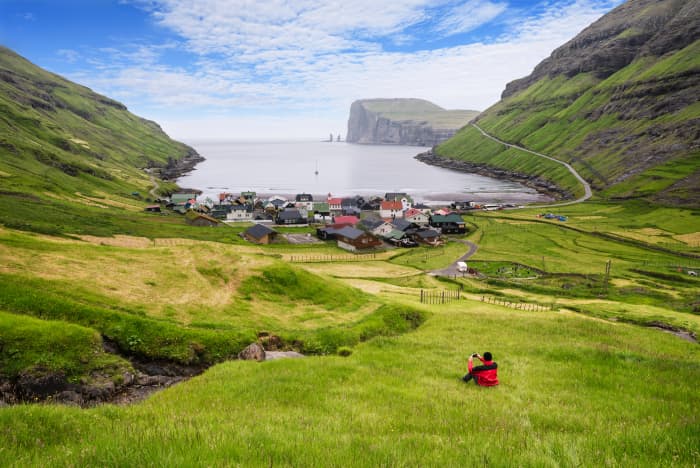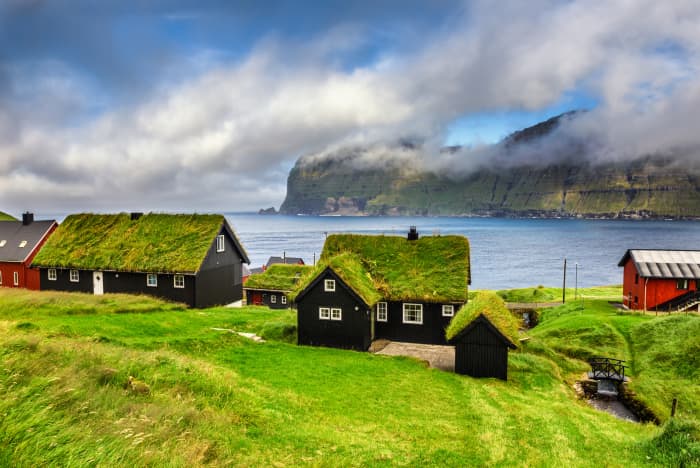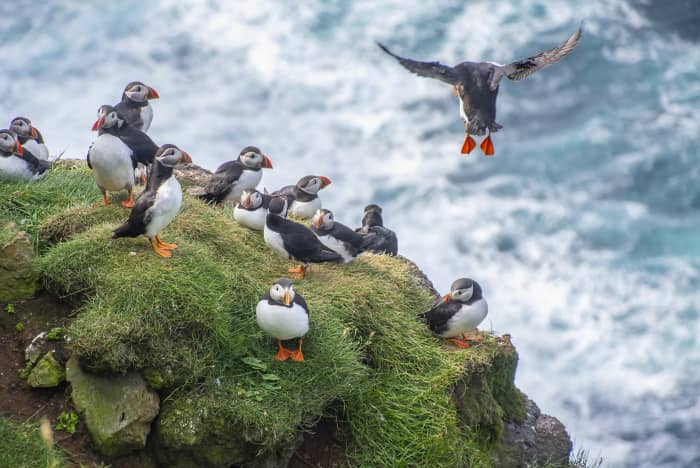This post was originally published on this site
This article is reprinted by permission from NextAvenue.org.
Halfway between Iceland and Norway in the North Atlantic sea sit the Faroe Islands, inhabited since at least the sixth century when monks sailing north from Ireland first discovered the place and settled there.
From a distance the destination looked like a clump of uninhabited and unfriendly volcanic peaks and outcroppings in dreary charcoal gray rising from the sea and nothing more. This craggy, wind-swept land where my ship docked seemed like an unlikely place to spend the day but I’m so glad that I did.
I’d never heard of the Faroe Islands before traveling from Western Norway to Iceland. As we approached, the looming, rugged, towering peaks of Torshavn didn’t seem a hospitable place and as I looked around at the mostly older adults disembarking the cruise ship, I wondered how we’d manage to get around once on land.
As it happens, these islands provide a perfect opportunity for older adults to navigate. Surprisingly, the streets of the capital were mostly flat or gently sloping and meander past turf-topped houses, built as the Vikings did when they invaded and settled around 800 AD.
Walking from the dock to the center of Torshavn, visitors will immediately spot the parliament building currently in use, but many centuries old, built on the site of the Vikings’ original settlement in the ninth century. Called Tinganes, which means “parliament point” in Faroese, this parliamentary meeting place is one of the oldest in the world dating back to the Viking period.

A Faroe Islands village with a view of the sea stacks Risin and Kellingin beyond.
istock
In many ways, a modern city
Peeking through the windows of the squat red brick buildings with grass roofs, it seemed incongruous to see computers and other modern technologies sitting on desks inside. But in many ways this is a modern city, with good cellphone reception.
Though there are 22 islands comprising the Faroe Islands, only three have much population. While the total population holds steady at around 30,000, currently 13,000 reside in the capital city of Torshavn, which I found charming to walk through by foot.

The Village of Mikladalur on the island of Kalsoy, Faroe Islands. Grass rooftops are common here.
istock
There is surprising livability in this ruggedly beautiful place. I spotted several young couples with small children in strollers going about their daily lives. Their youthfulness contrasted sharply with the ancient turf-topped houses and Parliament buildings. I also found the locals to be friendly and hospitable. Another bonus — most residents speak English well.
Also on MarketWatch: The best and most affordable places to live in Florida
A pleasing and peaceful place
Although off the beaten path, and maybe because of it, this is a pleasing, peaceful and physically breathtaking place to spend time. Here you are, away from the hustle and bustle of tourist spots with all-alike shopping malls and frenzied travelers.
And in the middle of the North Atlantic Ocean, this place gives you a respite from the geopolitical aggravations that persist almost everywhere these days. Escape for a short while from the troubles in America, Europe and the Middle East.
In the ocean midway between Norway and Iceland and due north of the tip of Ireland and Scotland, this far-flung archipelago is a Danish protectorate and a place where the old Norse language is still spoken. Also, thanks to Denmark, there are a series of bridges and tunnels that can take you, in your rented car, to other islands. Perfect for those who wish to explore the Viking history and natural beauty. Whether you are a seasoned mountain climber or more sedentary person who prefers to view the scenery from a car, this place is for you.
There is much to see beyond the capital city. If you are a nature lover, you are in for a treat as the mountain roads look down at incredibly dramatic views of fjords. You can take the 3-mile underwater tunnel to Vágar where the charming village of Sandavagur was first settled by the Vikings. Wherever you drive, across many bridges or through the numerous tunnels, you arrive at scenery that is magnificent from the coastal vistas to the soaring peaks.
Read: Why you should chuck it all and move to Alaska
Because it is so remote, the only wildlife comprises puffins, kittiwakes, other sea birds and sea life including whales and local fish, upon which the local inhabitants depend for consumption and export.

Birders can spot puffins and other sea birds in the Faroe Islands.
istock
Something for everyone
The greenery seen everywhere belies the fact that very few fruits and vegetables can grow here. Wind off the ocean from every direction brings a saltwater mist that most edible plants don’t appreciate. So most fruit and vegetables are imported. Though there are no native animals, sheep are ubiquitous, for food and wool. Lamb, mutton and fish are the main proteins available to locals.
From the look of the islands, the gray foreboding sky, the appearance of the Northern Lights at certain times of the year, you’d think that the weather so close to the Arctic circle would be terribly cold all of the time. In fact, the temperature seldom goes below freezing, with less than an inch of snow, and cool summers with highs in the mid-50 degrees — in many ways a temperate climate.
You might like: 6 seaside getaways off the beaten path
Getting there is surprisingly easy by ship travel between Norway and Iceland, a plus for retirees who make up the majority of cruise ship passengers. There are also ferries between Iceland and Faroe Islands that carry cars so that you can explore the islands easily — a benefit to older adults. There are also daily flights to Torshavn from several major cities including Copenhagen, Oslo, Reykjavik, and even Paris.
Modern, medieval and early Christian periods complement each other in this unusual venue. Here there is something for everyone: lovers of history, birders, explorers and hikers-on-foot will all find their time in this place special and unique.
Francine Toder, Ph.D. is an emeritus faculty member of California State University, Sacramento and is a clinical psychologist retired from private practice. She is the author of “The Vintage Years: Finding your Inner Artist (Writer, Musician, Visual Artist) After Sixty” and “Inward Traveler: 51 Ways to Explore the World Mindfully.” Her extensive writing on diverse topics appears in magazines, professional journals, newspapers, blog sites and as edited book chapters. She resides in the San Francisco Bay Area.
This article is reprinted by permission from NextAvenue.org, © 2022 Twin Cities Public Television, Inc. All rights reserved.
More from Next Avenue:

